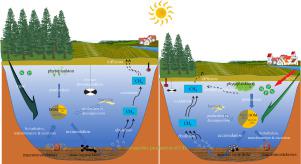Water Research ( IF 11.4 ) Pub Date : 2022-09-30 , DOI: 10.1016/j.watres.2022.119190 Yun Zhang 1 , Jun Wang 2 , Juan Tao 3 , Yongqiang Zhou 4 , Hong Yang 5 , Xuan Yang 6 , Yuanrui Li 7 , Qichao Zhou 8 , Erik Jeppesen 9

|
Many factors have been reported to affect material cycling in lakes, but the combined and cascading impacts of external environmental factors and in-lake biota on lake carbon cycling are poorly understood. We elucidated the influencing pathways of geoclimatic factors, lake morphometry, land-use type, chemical and physical factors, and biological taxa (phytoplankton and macroinvertebrates) on the concentrations of two important components of carbon cycling, i.e., dissolved organic matter (DOM) and methane (CH4) based on datasets from 64 plateau lakes in Southwest China. Partial least squares path modelling (PLS-PM) indicated that (1) geoclimatic factors influenced DOM and CH4 by affecting land use and lake physical factors (e.g., water temperature), (2) lake morphometry (water depth and lake area) had a direct and great negative effect on the CH4 concentration related to the production and oxidation of CH4 and affected phytoplankton and macroinvertebrates by influencing chemical and physical factors, (3) land-use type affected DOM and CH4 concentrations in both direct and indirect ways, (4) terrestrial humic-like DOM was mainly discharged from forestland and also affected by macroinvertebrates, while the impacts of agricultural and construction land on autochthonous DOM and CH4 concentrations mainly occurred by changing nutrients and then the aquatic biota. Moreover, changes in aquatic biota, primarily affected by water quality, influenced DOM spectral properties, and the two biotas affected DOM and CH4 concentrations differently. Phytoplankton, especially cyanobacteria contributed to (protein-like and humic-like) DOM in both direct and indirect ways related to eutrophication, whereas macroinvertebrates influenced DOM possibly by utilization, bioturbation, and microbial decomposition of feces according to their different relationships with DOM spectral indices. Additionally, CH4 production can be enhanced by DOM accumulation, and the significant positive correlations of CH4 concentrations with protein-like DOM and biological index indicate that autochthonous DOM may play an important role for the CH4 production. Our findings contribute to the understanding of lake carbon cycling under natural conditions and anthropogenic disturbances.











































 京公网安备 11010802027423号
京公网安备 11010802027423号